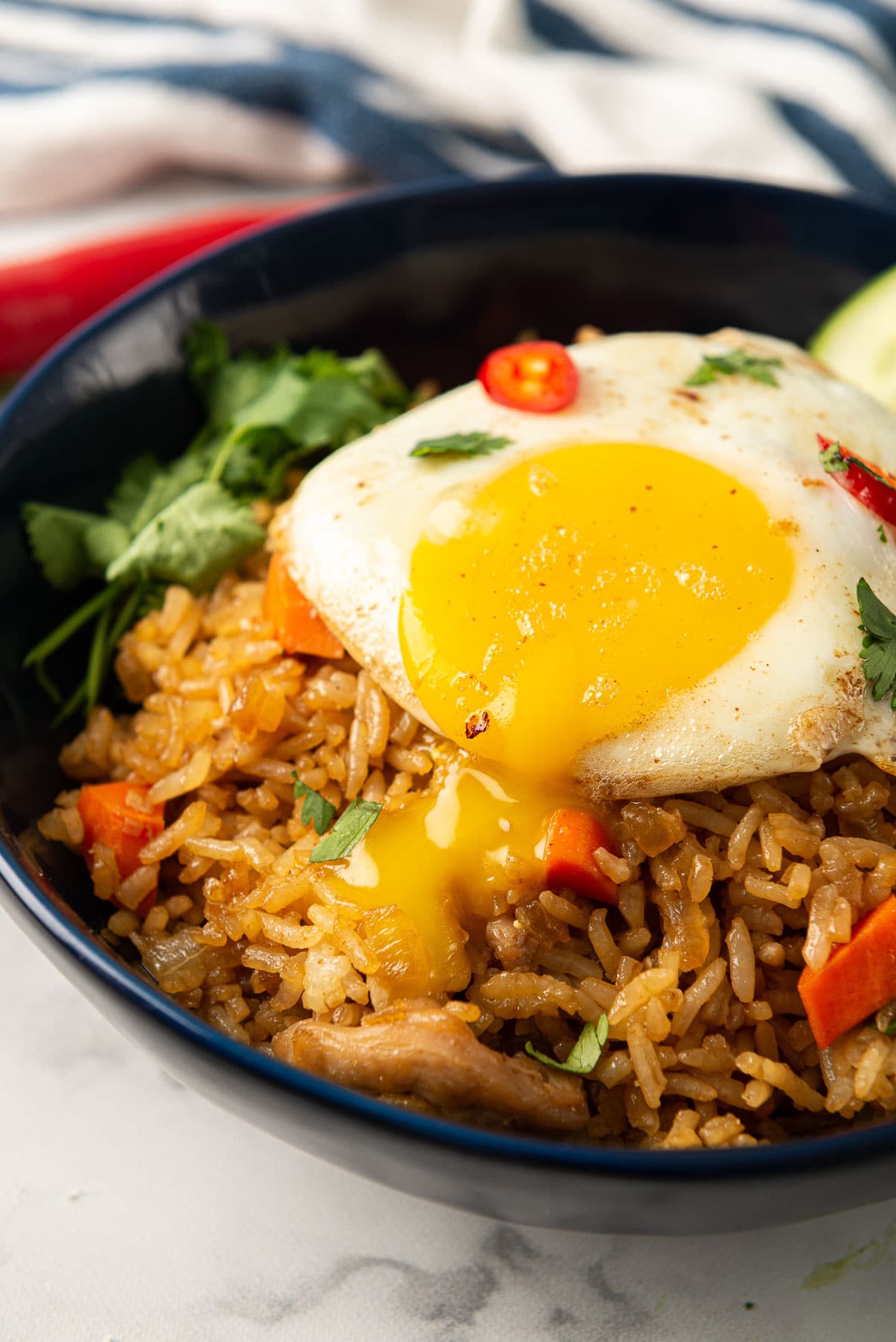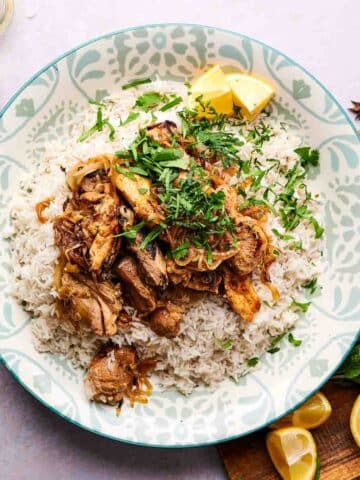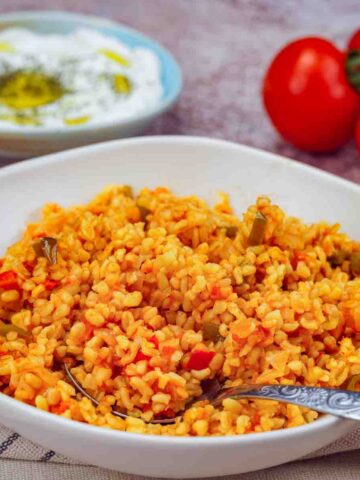Nasi Goreng is Indonesia’s take on fried rice. It’s very slightly sweetened due to a little kecap manis, with a hit of spice from sambal oelek. If a lot of those words don’t mean anything to you, don’t worry. I’ll walk you through this. We’re going to make this delicious and versatile fried recipe, and then we’re going to top it off with a perfectly fried egg.
Jump to:
I’ve loved nasi goreng since I was a child (I used to ask my Indonesian babysitter to make it for me all the time).
Traditional recipes like fried rice vary from home to home. In a country as large as Indonesia, you can imagine, there will be a lot of variety to how this recipe is tackled. And even concerning the history of the recipe!
I order the nasi goreng whenever I’ve seen it on a restaurant menu, but it’s strange that almost every version of it has been completely different from the others – I’ve had vegetarian versions, versions made with hot dog pieces, and this version – which is my take on it, and my personal favourite. (I’m a little biased towards myself, bestie!)
What is Nasi Goreng
Simply put, Nasi Goreng is Indonesian fried rice. It is typically flavoured with kecap manis (a sweet soy sauce), sambal oelek (a chili paste), and served with a fried egg on top. It is not uncommon to find recipes that use belacan (dried shrimp) or terasi (shrimp paste) in their recipe too (although, I don’t require it in my take on this classic fried rice dish).
Where is it from
Nasi goreng is from Indonesia, however its origins are not clear. Some sources trace the recipe’s roots back to Chinese fried rice, other sources refute this and say that the Indonesian fried rice was developed entirely separately. Other sources suggest that the recipe is actually derived from some Middle Eastern recipes.
Regardless of where it originated, nasi goreng is a household favourite (especially as a way to use up day old rice) in Indonesia, and its neighbours, Malaysia and Singapore.
What does it mean
Nasi goreng is Indonesian for “fried rice”.
Do you eat nasi goreng with chopsticks
Generally speaking, chopsticks aren’t used much in Indonesia – in terms of utensils, most food is eaten with a spoon and fork. That said, there are pockets that use chopsticks a lot more. So…the answer is no. But sometimes yes.
I included chopsticks in my photos because…well, I just thought they looked pretty.

Nasi Goreng Tips
One of the best things about nasi goreng is that there really isn’t much to it. No secret techniques or fancy equipment required, just standard fried rice etiquette:
- Opt for day-old cooked rice for this recipe. Day old rice is drier than freshly cooked rice, so it’s better for stir frying. Any sort of long-grain rice will work fine. I typically use basmati, but jasmine rice is a favourite of many.
- Kecap manis is delicious. But don’t go crazy with it. I know, I know…umami and all that. But don’t go overboard, and drown your rice in soy sauce. I’ve tried it. It’s not a good result!
- A crispy fried egg makes an excellent companion to this fried rice recipe. Baste your egg with a little oil/butter to crisp up its edges for a little added texture to your meal.
Indonesian ingredients
Kecap manis
Kecap manis is a sweet Indonesian soy sauce. It is thicker than most soy sauces, with a consistency closer to maple syrup. You can generally find it in most large supermarkets.
Note: Occasionally, it is called ketjap manis – this is the same thing.
How to make Kecap manis at home
It’s actually quite easy to make kecap manis at home. Of course, it’s not a perfect substitute, but it’s pretty good. All you need to do is stir ¼ cup of soy sauce (just regular soy sauce…not a special variation) with a ¼ cup of brown sugar over medium heat. Bring the mixture to a simmer, and allow it to reduce until it thickens. You’re looking for that maple syrup consistency.
Keep in mind that as the mixture cools (even once it’s off the heat), it will continue to thicken slightly.
Sambal Oelek
Sambal oelek is an Indonesian chili paste, you can swap it out with half a teaspoon of red chili powder, or omit it entirely (if you have trouble with spice). It is available in the Asian food aisle of most large grocery stores. Some people prefer to omit this, and instead garnish with a chopped red chili for extra spice and a pop of colour.
Belecan
Belecan (Indonesian dried shrimp) is a popular addition (some recipes use terasi, which is a shrimp paste) to nasi goreng recipes. I don’t use it in this recipe, and it’s certainly not an essential item, but you can add it for a little extra hit of flavour.

Recipe Variations
Like most fried rice recipes, nasi goreng can be mixed up quite easily. Here are a few quick suggestions:
- Make a vegetarian version without chicken. Of course, you can swap the chicken for any protein you prefer – beef, shrimp, and tofu variations are all popular!
- Add in belacan (dried shrimp) and see what you think! Add it in or use 2 teaspoons of shrimp paste. (You’d mix it in at the same time as the cold rice).
- Swap out the chicken for pieces of chopped up hot dogs. This is actually something my babysitter used to do for me as a child!
- If you don’t like fried eggs, you can also cook an omelette – chop it up and mix it into the cooked nasi goreng. (If you want to eat this the way it was made for me as a child, add a squirt of ketchup on the side.)
Nasi goreng is NOT a side dish!
You’re probably wondering what this section is all about. Well, while researching this post, I came across a lot of blog posts or articles suggesting that nasi goreng is a common side dish. It is not. If you’ve grown up anywhere in Asia, you know that fried rice is never a side dish! Let’s do a thought exercise:
Imagine an eight-year-old Riz. Hungry. Cute. Impeccable table manners. And then imagine him looking up at his mother saying, “Hey, thanks for taking the time to make this Indonesian fried rice. But what are we having for the main dish?”
(The answer is shoes, bestie. Eight-year-old Riz would be eating shoes. And not willingly.)
Unless you’re at a party with multiple main courses…nasi goreng is the main course. Don’t let anyone tell you different. Think about it…have you ever had a side order of fried rice? Fries? Sure. Brussel sprouts? Works. Fried rice? Sacrilege.
(I’m kidding. My mummy is lovely. She never threw shoes at me. This message is not written under duress.)

Storage instructions
Generally speaking, fried rice can be refrigerated for two to three days after which it starts to get dry. If you’re on day five, I find that you can sometimes salvage it by sprinkling a little water on top before microwaving it.
Can nasi goreng be frozen
Nasi goreng (minus the egg) can be frozen for up to two months. Personally, I find that the texture isn’t quite as nice after it’s been frozen though.
More dinner recipes
Here are a few other dinner ideas, inspired by international cuisine:
- Easy Filipino Chicken Adobo
- Al Baik Chicken (Saudi Arabian fried chicken)
- Swedish Toast Skagen
- Chaliapin Steak (from Japan)
- Pastilla (Moroccan Chicken Pie)
Helpful tools
The link below is an affiliate link. This means that if you choose to purchase using it, I will receive a small commission (at no additional cost to you). These small commissions help keep Chocolates & Chai going. Thank you.
There’s very little you need to make Indonesian fried recipe, however this Kecap manis, is certainly worth picking up.
If you like what I’m doing here, and you want to help, why not go ahead and become a Patron? You can support Chocolates & Chai for as little as the price of a cup of coffee!
And that’s a wrap! Have you ever had nasi goreng? What did you think of it? If you made my recipe, please do comment below and let me know what you thought of it!
Don’t forget to follow me on Facebook, Pinterest, Instagram, YouTube and Twitter for all the latest. Or just sign up to be a part of my mailing list to have updates delivered straight to your inbox!

📖 Recipe

Nasi Goreng (Indonesian Fried Rice)
- Total Time: 25 minutes
- Yield: A pot of nasi goreng
- Diet: Halal
Description
Nasi Goreng is the Indonesian version of fried rice, served with an egg on top. It’s scrumptious.
Ingredients
For the Nasi Goreng
- 150g chicken thigh, thinly sliced
- ½ cup onion, diced
- 1 tbsp kecap manis
- 2 garlic cloves, minced
- 1 tsp ginger, chopped
- 1 tsp coriander, ground
- 1 tsp cumin, ground
- ¼ cup carrots, diced
- 1 tbsp sambal oelek (chili paste – optional)
- 4 cups precooked white rice, cold (day old)
- ¼ cup kecap manis
For the Garnish
- 4 fried eggs, seasoned to taste
Instructions
- Heat oil in a frying pan over medium-high heat. Once hot, add chicken and onions, and cook until the onions start to become fragrant, 2-3 minutes.
- Add garlic, ginger, sambal oelek (if using), coriander, cumin, and carrots. Stir together, and continue cooking until the chicken has almost cooked through. Mix in 1 tablespoon of kecap manis, and cook for one minute.
- Mix in the rice, and cook until the rice heats up and begins to crisp ever-so-slightly (just be careful not to burn the rice, bestie!). Turn off the heat, mix in ¼ cup kecap manis. Season with salt or more kecap manis, to taste.
- Top each serving with a fried egg.
Notes
- Kecap manis is a sweet Indonesian soy sauce, it is usually available in Asian stores as well as large supermarkets.
- Sambal oelek is an Indonesian chili paste, you can swap it out with half a teaspoon of red chili powder, or omit it entirely (if you have trouble with spice). It is available in the Asian food aisle of most large grocery stores. Some people prefer to omit this, and instead garnish with a chopped red chili for extra spice and a pop of colour.
- Make sure to use day old cooked rice for this recipe. It’s a little drier than freshly cooked rice making it better for stir frying.
- Some nasi goreng recipes call for the addition of belacan (dried shrimp), I don’t use it in my recipe. However, you can add it in or use 2 teaspoons of shrimp paste (you’d mix it in at the same time as the cold rice).
- You can swap the chicken out for whatever protein you fancy – beef, shrimp, and tofu are other popular options.
- This recipe can be refrigerated in an airtight container for up to 3 days.
- Prep Time: 10 minutes
- Cook Time: 15 minutes
- Category: Main Course
- Method: Stovetop
- Cuisine: Indonesian









Lara
So excited to see you feature nasi goreng! Grew up with it as the only fried rice cooked in our house due to my father growing up in Jakarta. Cannot cook it as well myself though, because my dad is a “bit of this and that” kind of cook. Psyched to try your recipe!!!!! (Tried my first recipe of yours today, Cilbir. It was AMAZING!)
Riz
Oh!! I’m so happy to hear this…I hope you enjoy the recipe (it’s certainly a blast from the past type of recipe for me too!). And thank you so much for trying the Cilbir! I’m glad you enjoyed it so much!!
Riz
Lara
Your recipe was right on! Gave it a whirl, and it was the FIRST time I successfully made a Nasi goreng that I loved. I’ve tried several recipes, but it was never quite right. This tasted like my dad’s 😍
Riz
Oh! Thank you so much, what a lovely thing to say! I’m so glad you enjoyed it. Wishing you many happy nasi gorengs dinners in the future 🙂
L S
We lived in Jakarta for 4 wonderful years in the very early 90s. This was a wonderful blast from the past. And you’re right on the money about the chopsticks! So many of our family here in CT assume we must have been eating with chopsticks but we have to explain that it was a spoon and fork for rice!)
Riz
Thanks so much for your comment! I hope you enjoy the recipe!!!